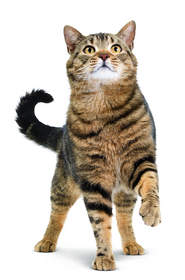MISSION, KS--(Marketwire - Sep 13, 2012) - (Family Features) Cats are known as mysterious creatures. While some of the things they do can be puzzling at times, you don't have to be a super sleuth to decode your pet's behaviors.
Steve Dale, certified behaviorist, author and host of "Steve Dale's Pet World" radio show, has answers for common questions about feline quirks.
What does it mean when my cat rubs her chin and body against me?
A lot of cat owners assume that rubbing is a sign of affection. What we do know is it might actually mean is that your cat is marking her territory. Cats don't only rub their people in this way -- they may rub up against doors, chair legs and the computer on your lap.
Cats have scent glands in their cheeks and sides. So when they rub on something, the cat is leaving its personal mark, depositing pheromones. This lets other cats know that they've staked a claim to a particular bit of territory -- including you. So in a quirky feline way, it is a sign of affection.
When my cat sniffs something, sometimes her mouth is open and lips are pulled back -- what is that about?
The feline sense of smell is much stronger than that of humans. While people have about five million odor-sensitive cells in their noses, cats have about 200 million. Cats also have an extra olfactory organ, called the Jacobson's organ, located on the roof of the mouth and connected to the nasal cavity. So when your cat gets a whiff of something unusual or especially interesting, she will open her mouth and inhale the scent so it reaches the Jacobson's organ. This intensifies the smell and gives your cat more information about whatever she is sniffing.
I've heard that spaying or neutering cats makes them lazier -- is that true?
Spaying and neutering can help cats live longer lives, prevent unwanted litters and reduce territorial behaviors. However the hormonal changes that come with spaying and neutering can cause an up to 20 percent increase in appetite and an up to 30 percent decrease in metabolism. These changes mean that spayed or neutered cats are almost 3.5 times more likely to be overweight than other cats, putting them at an increased risk for obesity. Feline obesity is an epidemic and can eventually lead to other health issues, such as diabetes, arthritis and non-allergic skin conditions.
It's important to help spayed and neutered cats maintain a healthy weight, ultimately promoting better health and potentially adding years to their lives. For example, the new SPAYED/NEUTERED line of feline formulas from Royal Canin helps control a cat's appetite and support their decreased energy needs. Learn more about the new foods at www.Facebook.com/RoyalCanin.US.
About Family Features Editorial Syndicate
This and other food and lifestyle content can be found at www.editors.familyfeatures.com. Family Features is a leading provider of free food and lifestyle content for use in print and online publications. Register with no obligation to access a variety of formatted and unformatted features, accompanying photos, and automatically updating Web content solutions.
Contact Information:
Matthew Barksdale
mbarksdale@familyfeatures.com
1-888-824-3337
http://editors.familyfeatures.com
